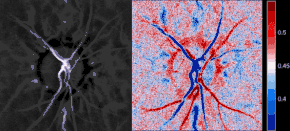Arterial resistivity index
The arterial resistivity index (also called as Resistance index, abbreviated as RI), developed by Léandre Pourcelot , is a measure of pulsatile blood flow that reflects the resistance to blood flow caused by microvascular bed distal to the site of measurement.
| Arterial resistivity index | |
|---|---|
 Arterial resistivity index (right) from retinal laser Doppler imaging (left). | |
| Purpose | measure of pulsatile blood flow |
Description
| Resistance index | Description |
|---|---|
| 0 | Continuous flow |
| 1 | Systolic flow, but no diastolic flow |
| >1 | Reversed diastolic flow |
The RI is altered not by vascular resistance alone but by the combination of vascular resistance and vascular compliance.[2][3]
Normal mean renal artery RI for an adult is 0.6 with 0.7 the upper limit of normal. In children, RI commonly exceeds 0.7 through 12 months of age and can remain above 0.7 through 4 years of age.[4]
Uses
Medical ultrasonography
It is used in ultrasound testing of umbilical artery for placental insufficiency. RI should not exceed 0.60 at 30 weeks of gestation.[5] RI is also commonly used to monitor kidney status, especially following kidney transplant. Following kidney transplantation, patients with an RI > 0.8 have an increased mortality.[4][6]
Medical laser Doppler imaging
Mapping of the local arterial resistivity index from laser Doppler imaging enables unambiguous identification of retinal arteries and veins on the basis of their systole-diastole variations, and reveal ocular hemodynamics in human eyes.[7]
See also
- Pulsatility index
- Leandre Pourcelot (French)
References
- Sistrom, Theodore E. Keats, Christopher (2002). Atlas de medidas radiológicas. Madrid: Harcourt. pp. 481. ISBN 978-84-8174-612-9.
{{cite book}}: CS1 maint: multiple names: authors list (link) - Bude, RO; Rubin, JM (May 1999). "Relationship between the resistive index and vascular compliance and resistance". Radiology. 211 (2): 411–7. doi:10.1148/radiology.211.2.r99ma48411. PMID 10228522.
- Boas FE, Desser TS, Kamaya A (2011). "Does separating the resistive index into pre- and post-glomerular resistance and vascular compliance improve the diagnostic accuracy of renal transplant doppler ultrasound?". American Journal of Roentgenology. 196 (5): A84–A87. doi:10.2214/ajr.196.5_supplement.0a84.
- American Journal of Roentgenology. 2003;180: 885-892. 10.2214/ajr.180.4.1800885
- Hobbins, John C. (2007). Obstetric ultrasound : artistry in practice. Oxford: Blackwell. p. 37. ISBN 978-1-4051-5815-2.
- N Engl J Med. 2013 Nov 7;369(19):1797-806. doi: 10.1056/NEJMoa1301064.
- Puyo, Léo, Michel Paques, Mathias Fink, José-Alain Sahel, and Michael Atlan. "Waveform analysis of human retinal and choroidal blood flow with laser Doppler holography." Biomedical Optics Express 10, no. 10 (2019): 4942-4963.